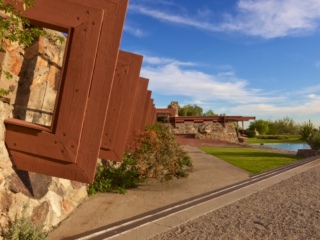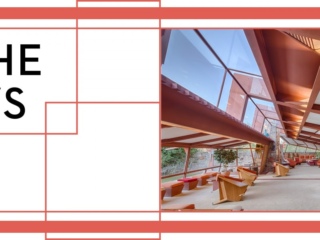
Preservation Team Uses Modern Techniques to Restore Taliesin West Board Room
Emily Butler | May 28, 2019
Frank Lloyd Wright Foundation Taliesin West Preservation Manager Emily Butler dissects the process of the preservation of Taliesin West’s Board Room, and how the team is utilizing innovative technologies to embrace the Board Room’s rich history, as well as uncover new details of the historic space.
Preservation work is a lot like conducting an archaeological excavation of a building. As you peel back architectural elements you get to the core of what the original builder had intended for the space, what his or her obstacles were, and their creative solutions to overcome them. It was with this is mind that we began to undertake the extensive stabilization and preservation of the Board Room at Taliesin West. In keeping with this archaeological analogy, is fortunate that we have a trained archaeologist leading our Board Room wood conservation project, who also happens to be a local skilled preservation carpenter and craftsman.
The Board Room, as we now call it, was the Fellowship’s original dining room. It was constructed during the winter of 1938 to 1939, making it one of the earliest buildings at Taliesin West. The desert masonry structure, and its redwood cantilevered beams with decorative wooden icicles dripping from them, serves as a stunning visual anchor for the main southwestern elevation of the site.
As with all buildings at Taliesin West, the space underwent multiple aesthetic, structural, and functional changes over the course of its life. A relatively small space at approximately 700 square feet, the Fellowship eventually grew out of this space and enlarged and enclosed the loggia, which is still in use today as the main dining area. It was then used as a small, private dining room and is now used as classroom space for the School of Architecture at Taliesin.
Throughout its history of alterations, the building has retained a high degree of integrity – most notably in its wood members. Based on wood analysis conducted by University of Pennsylvania’s Preservation Program student, Mia Maloney, we know that much of the wood is Redwood, leading us to believe that this building retains some of the oldest wooden members at Talien West.
Wright initially used unpainted Redwood throughout the construction of Taliesin West, which was easily sourced and relatively inexpensive at the time. Over time, the Redwood was removed and Douglas Fir, painted Taliesin Red, was introduced.
As you might imagine, with age of material comes an increased likelihood of deterioration. That is most certainly the case with this space. The Board Room’s four cantilevered built-up Redwood beams have suffered from ultraviolet, wind, water, and termite damage.
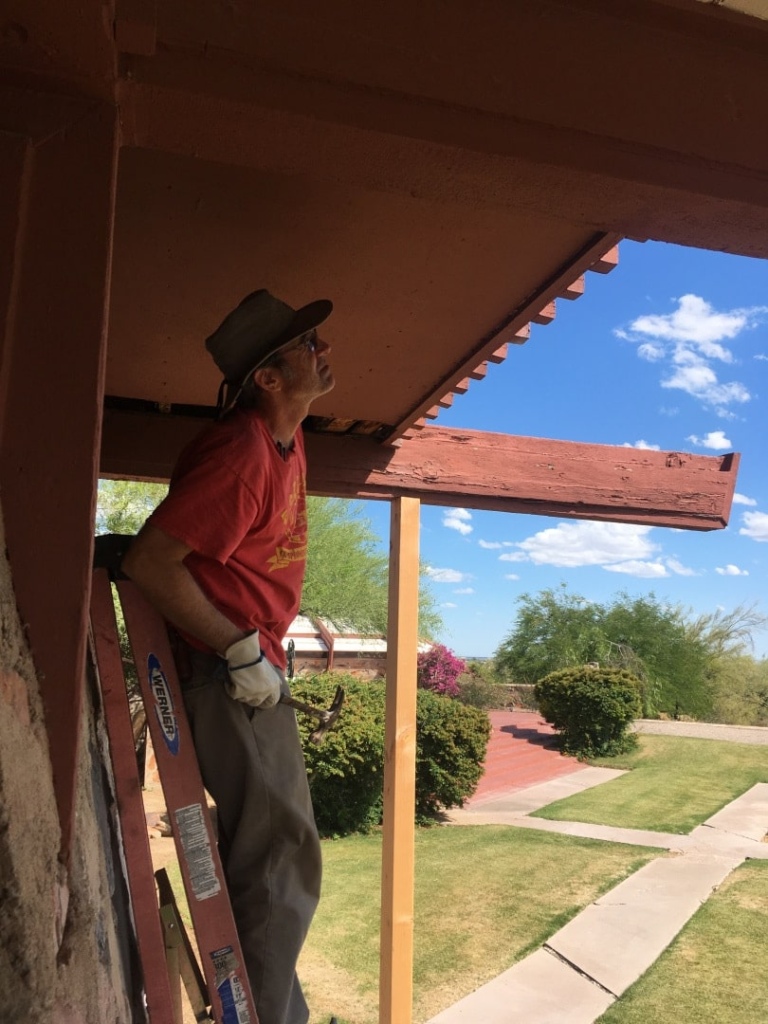
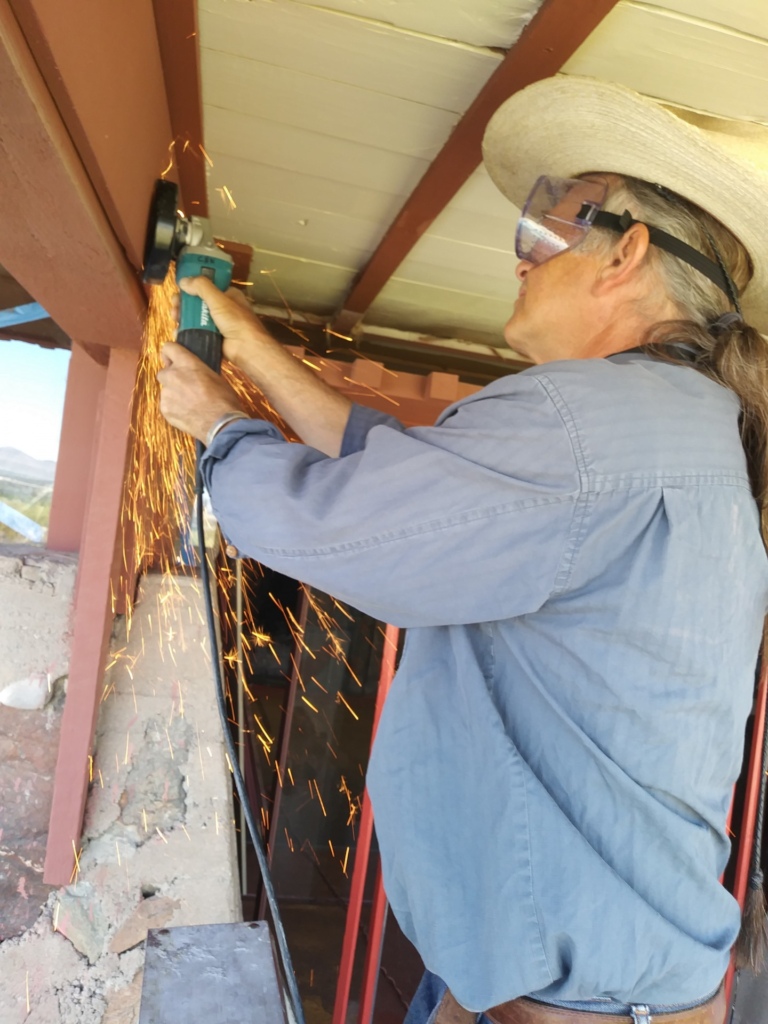
A combination of these forces have compromised the structural integrity of two of the main beams, their support systems, and many ancillary and decorative members.
We are currently underway on a comprehensive stabilization and preservation project that encompasses the main exterior and interior structural members as well as the decorative elements. The goal of the project is to, primarily, stabilize any structurally compromised wood members. Each beam consists of approximately five, true dimension, 2x wood beams sandwiched together. This unique built-up beam construction, common at Taliesin West, allows us to gently peel off and analyze each piece.
In addition to the main structural analysis, all of the interior wood elements have been carefully documented, mapped, and removed for individual analysis and appropriate conservation. Each piece will be repaired, or replaced in-kind where necessary, and put back in its original location.
It is our goal to retain as much original material as possible using modern wood preservation techniques. Where severe deterioration is present, we will use a combination of selected dutchman style repairs, epoxy fills, and wood consolidation to preserve and retain the piece. If the deterioration is too extensive, the element will be replaced in-kind.
Paint analysis was also conducted by UPenn student Mia and her advisor, John Hinchman. Over time, original paint colors can be distorted by years of dirt and sun fading causing improper paint matches. Using their analysis, we are able to identify original paint layers and pigmentation. Once this is determined we will have a custom color mixed by PPG Paints to repaint the woodwork.
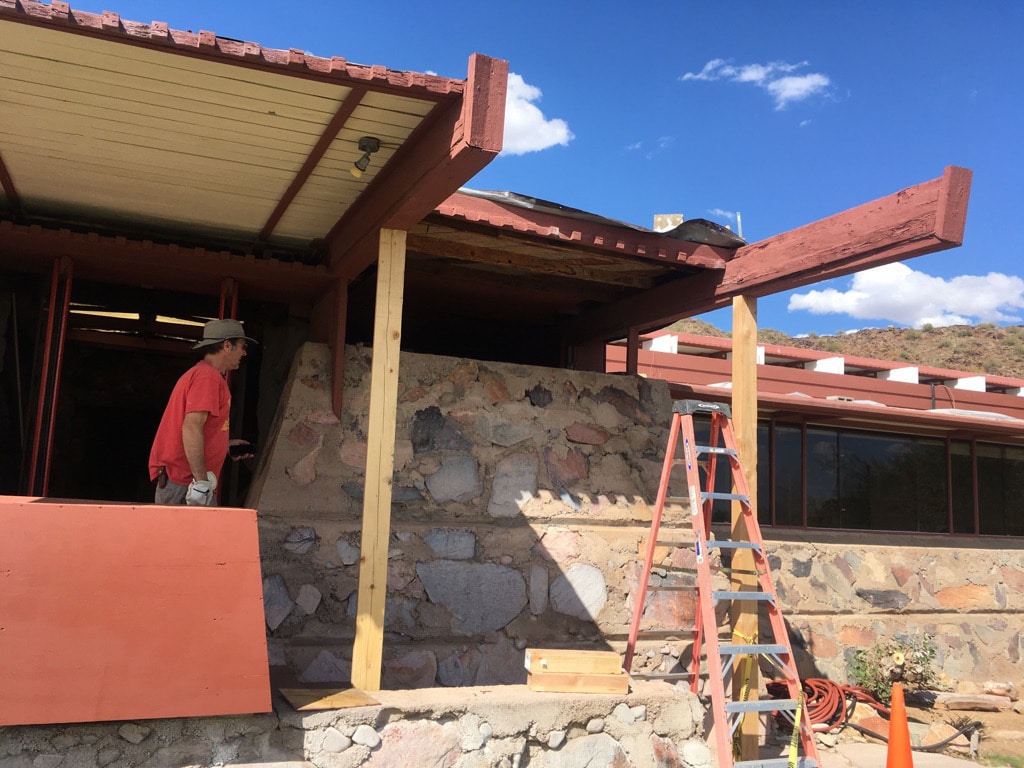
To properly protect the newly preserved woodwork, the Board Room roof is being replaced as well as the skylight. We will be using an elastomeric coating system on this roof, which we commonly specify on our roof replacement campaigns. The skylight, originally constructed of canvas flaps and then changed to clear glass in the early 1950s, is currently a fiberglass system installed in the mid-1960s. Nearing the end of its useful life, we have decided to bring back the value of natural light and connection to the landscape that the clear glass would have provided and replace the current system with a clear structural polycarbonate skylight system.
This project is intended to be a ‘light-touch’ preservation undertaking. The age and existing condition of the wood, while vital that it be properly preserved to extend its life, gives a unique sense of how Taliesin West was at once raw and unfinished, but also elegant. The original rough sawn Redwood has a unique character that, no matter how hard we tried, we could never truly replicate. With that in mind, and our ever-present desire to retain the original feeling of the space within, we are happy that we will be able to retain much of the original wood, bring back the quality of light provided by the clear skylight, and retain the aesthetic and experiential values of the space.

